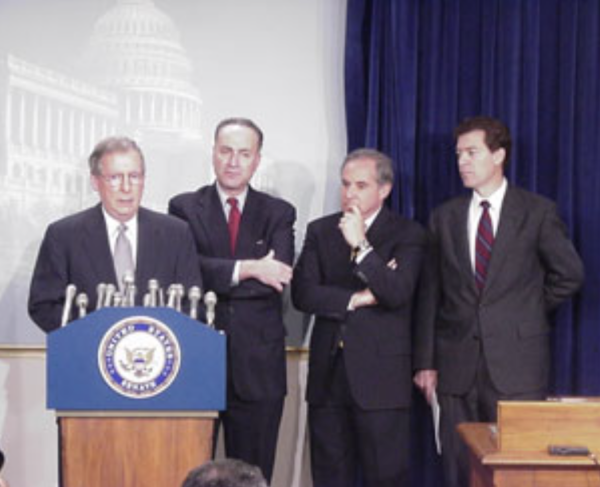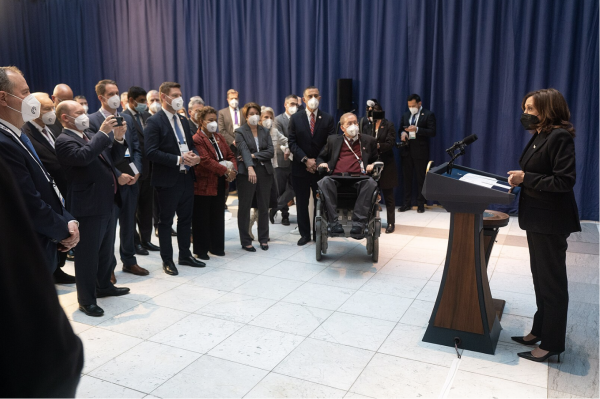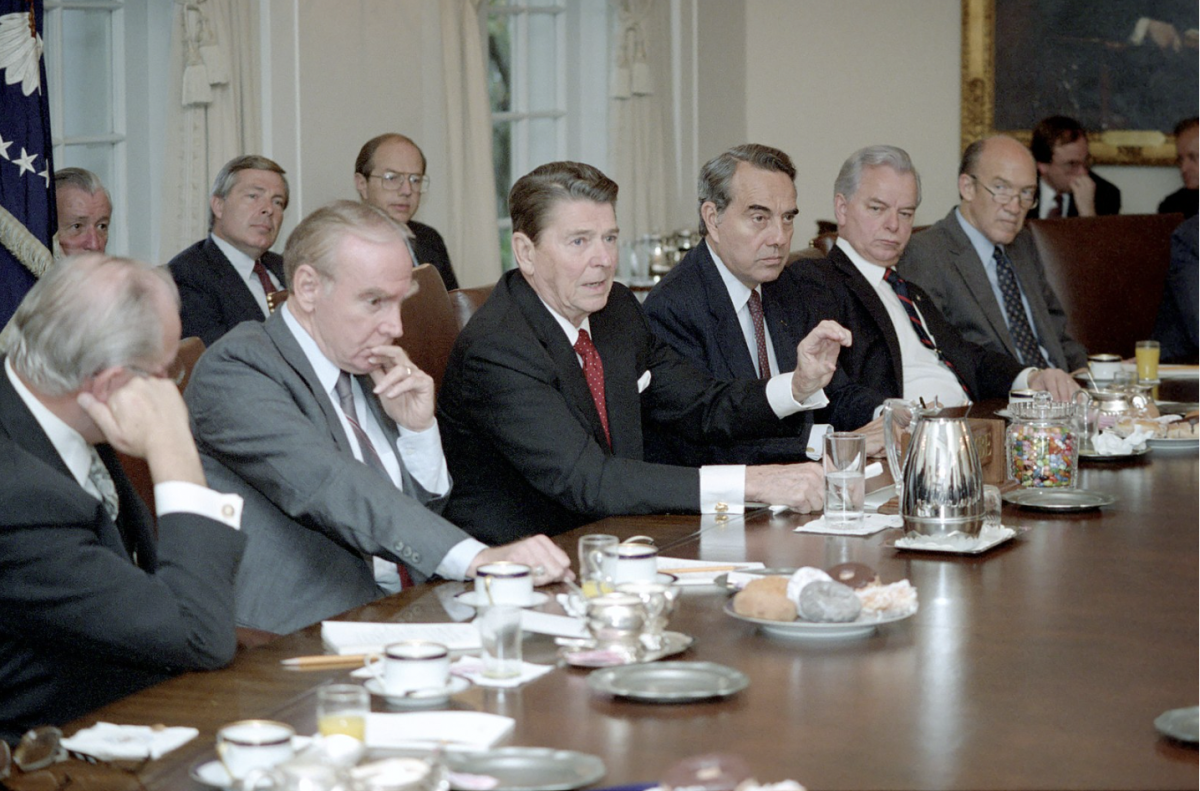As the 2024 election cycle picks up, it seems as if one question is on people’s minds: red or blue? However, this question fails to acknowledge that politics is not as simple as picking one side over another. In order for our country to function, compromises between both sides of the political spectrum are essential.
American bipartisanship traces its roots back to the Constitutional Convention. During the summer of 1787, states’ delegates were so intensely divided over how congressional seats should be allocated that the topic nearly marked the end of the new republic. Representatives from small states opposed any proposal that altered the equal representation they had under the Articles of Confederation while delegates from large, populous states viewed the existing system as being biased against them.
Ultimately, the Connecticut Compromise was drafted which provided for a bicameral federal legislature that used a dual system of representation: the Senate would have equal representation from each state, while the House of Representatives would have proportional representation based on a state’s population. Perhaps the first instance of bipartisanship laid an important precedent: compromise was essential to our nation.
Yet, in recent years, such cooperation has virtually been eliminated. Hyperpartisan divides outweigh meaningful discourse and party leaders prioritize political victories over policy solutions, leading to frequent gridlock and government shutdowns.
2023 was Congress’s least productive year since the Great Depression. Only 27 bills were signed into law despite 724 votes being held. Most bills passed in the House after receiving enough support from the Republican majority and then proceeded to fail in the Democrat-controlled Senate.
Part of this inefficiency is due to the partisan demographic changes. Ideological thinking is now much more closely aligned with partisanship than in the past. Thus, ideological overlap between the two parties has diminished. Today, 92% of Republicans are to the right of the median Democrat, and 94% of Democrats are to the left of the median Republican.
Political animosity has increased amongst the population as well. In 1994, a majority of Republicans had unfavorable impressions of the Democratic Party, but just 17% had very unfavorable opinions. Similarly, while most Democrats viewed the GOP unfavorably, just 16% had very unfavorable views. Since then, highly negative views have more than doubled: 43% of Republicans and 38% of Democrats now view the opposite party in strongly negative terms.
This is reflected in political strategizing as well. Dr. Laurel Harbridge-Yong, a professor of political science at Northwestern University, whose research specializes on partisan conflict commented on the reasons why bipartisanship has declined. “One reason is the collective electoral incentive. Let’s say if members of the Democratic Party want to become the majority in the House and they are presently in the minority, they have an incentive not to work with the Republicans because they want to make the Republicans look incompetent and this goes vice versa as well. Both parties want to be able to offer an alternative.”
Furthermore, during the 20th century, many senators shared their state with a senator from the opposite party. Not only did this reinforce the idea that either party could win a state, it also gave such senators an inherent bipartisan partner in the Senate, particularly on issues of concern to their home state. Today, however, only twelve senators have a colleague who is from the other party.

Many politicians have also adopted more hardline policy stances due to increasingly competitive primary races. The general electorate is more likely to want policy positions that are more moderate and are more likely to include a bipartisan approach to lawmaking. Meanwhile the primary electorate skews the opposite, which pulls members away from engaging in bipartisanship and toward more partisan behavior.
We have seen this trend especially manifest itself in the 2022 primary elections. In total 80 incumbents (179 in general elections and 229 in primaries) lost their seats to more extreme candidates, and several newcomers won races against established professionals.
Dr. Harbridge-Yong reflected “There is an incentive to side with partisan voters in the primary because the electorate is more likely to be unified in their policy positions. If you go against the median voter, the majority in the primary, you risk going against a large fraction of the electorate. Let’s say 70% of the primary electorate want you to take position A, and only 30% are opposed to that position. If you go with the minority, you have immediately alienated a lot of people. Whereas in the general electorate, it might be more like a 55% to 45% split.”
This strategy, while effective in winning primaries, contributes to the polarization and gridlock plaguing Congress. As candidates prioritize appealing to their partisan base, the space for compromise and collaboration across party lines diminishes. The result is a Congress increasingly divided across fundamental ideological lines, where finding common ground becomes increasingly elusive.
In the end, the average American constituent is the one who incurs the biggest loss. Studies have found that congressional approval is lowest when gridlock is attributed to strategic partisan behavior. On issues where parties disagree over the means but agree on the end goals of policy (i.e., consensus issues), gridlock was found to be an even worse option than a win for the opposing side. Some progress, even if it may be in a different form than what one intended, is better for most people than no progress.
While gridlock has historically been viewed as a tool for protecting minority opinions in Congress, its costs include preventing progress, hindering legal change, exacerbating divisiveness, and empowering factions. In this way, what was once was as a mechanism for safeguarding diverse viewpoints can inadvertently undermine democratic governance and hinder the pursuit of meaningful change.
However, while bipartisanship has declined in recent years, it is certainly not dead. In a political landscape marred by polarization and gridlock, the resilience of bipartisanship reminds us that unity, compromise, and collaboration remain essential to our democracy.
Dr. Jordan Tama, a professor of politics at American University, whose research specializes in political institutions and tools of U.S. foreign and national security policies commented, “Many people tend to see American politics in black and white. While I am not optimistic about American politics, I think it is important to recognize that there are still times when Democrats and Republicans work together. While elections and power are huge influences on politicians, there also are some politicians who actually want to try to accomplish things, which is the environment in which bipartisanship thrives.”

Studies have found that legislative effectiveness is heightened when members build bipartisan coalitions around the bills they sponsor. This pattern holds over time and for both majority and minority legislators. Engaging in bipartisan behaviors contributes to a virtuous cycle: those who cosponsor across party lines attract cross-party cosponsors to their own bills, which translates into greater legislative success for their agendas.
Dr. Harbridge Yong expanded, “My research has shown that how much bipartisanship has declined depends on where in the legislative process you look. For instance, if you look at the roll call voting records that members take when they are taking votes on bills on the floor, bipartisanship has declined. We are much more likely to see the majority of one party voting against the majority of the other party. However, if we look earlier in the legislative process, at the bills that members introduce and co-sponsorship coalitions, we find that some bipartisanship has continued. Although it has also declined, I found that it didn’t decline at quite the same rate. The slope of decline was steeper for voting than for co-sponsorship.”
While bipartisanship seems like a relic of the past, there is still hope for collaboration and compromise in our future. Despite the challenges posed by partisan divisions and strategic electoral incentives, there remain politicians who are committed to finding common ground and working across party lines. As we move forward, it is imperative that we recognize the value of bipartisanship in achieving legislative effectiveness and addressing the pressing issues facing our nation and use this knowledge to frame our understanding of politics.
While bipartisanship has declined in recent years, it is certainly not dead. In a political landscape marred by polarization and gridlock, the resilience of bipartisanship reminds us that unity, compromise, and collaboration remain essential to our democracy.

